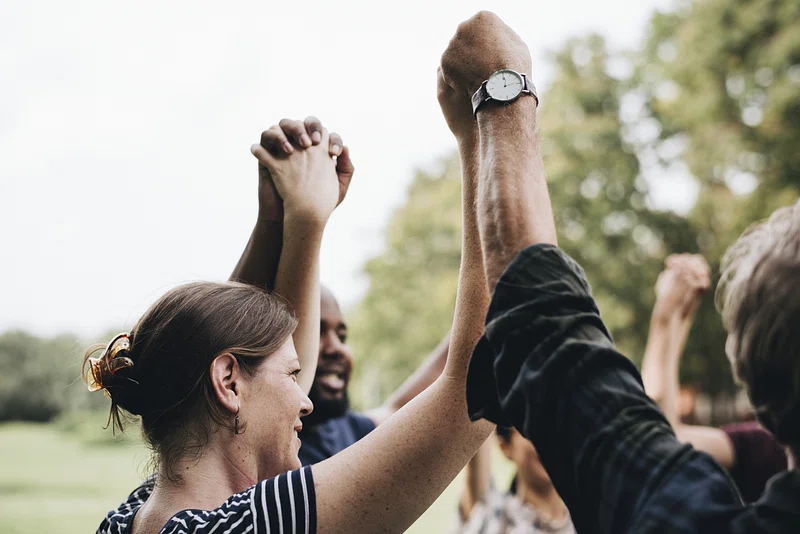In the intricate patchwork of life, we often find ourselves entangled in conflicts, disputes, and disagreements. It’s a part of the human experience, a canvas where differing perspectives clash, creating moments that can test our patience, resilience, and character. But in these moments, there lies a choice—one that transcends the immediate discord and leads us down a path of growth and wisdom. It’s the choice to be the bigger person.
Choosing to be the bigger person is an act of courage and grace, an affirmation of our capacity for personal evolution. It’s about rising above the turbulence of the moment and charting a course toward understanding, empathy, and resolution. And as we navigate this journey of self-discovery, there’s a guiding light, a philosophy rooted in the heart of Japan—the art of “Ganbatte.”
In the spirit of “Ganbatte,” we embark on a quest to not just do our best but to be our best, especially when faced with adversity. It’s a philosophy that echoes through time, reminding us that even in the face of challenges, we can choose growth over grievance. Join us on this transformative journey as we explore “7 Strategies for Rising Above: Becoming the Bigger Person,” where the essence of “Ganbatte” aligns seamlessly with the choice to rise above and become a better version of ourselves.

Understanding the Bigger Person
Definition and Context
In the intricate dance of human interactions, the notion of being the bigger person often emerges as a guiding principle. It’s an ethos that transcends specific situations and carries universal significance. To truly understand it, let’s dive into what it means to be the bigger person across various life scenarios.
Being the bigger person entails embodying maturity, emotional intelligence, and empathy when faced with conflicts, disputes, or challenging interpersonal situations. It signifies a conscious choice to rise above pettiness, anger, or the desire for revenge. Instead, it’s about approaching these situations with grace, wisdom, and the intention of fostering understanding and resolution.
Challenges and Misconceptions
Choosing to be the bigger person is not without its obstacles. It’s a path laden with challenges, often rooted in deeply ingrained human tendencies. Ego, for instance, can be a formidable adversary. The reluctance to let go of pride, or the fear of appearing vulnerable, can hinder the decision to take the higher road.
Misconceptions about being the bigger person are also prevalent. Some believe that it implies weakness or capitulation, that it means forfeiting one’s dignity. However, this choice is far from a retreat or submission. Instead, it’s an assertion of inner strength and a commitment to resolving conflicts constructively.
The Power of Growth and Relationships
The decision to be the bigger person wields immense transformative power. It’s a catalyst for personal growth, akin to the “Ganbatte” spirit that permeates the pursuit of self-improvement. When we choose this path, we embark on a journey toward emotional resilience and self-awareness.
Furthermore, being the bigger person is a formidable instrument for strengthening relationships. By demonstrating maturity and empathy, we can de-escalate conflicts, build bridges of understanding, and sow the seeds of harmony. It’s an echo of the “Ganbatte” philosophy, which emphasizes perseverance and improvement in our interactions with others.
In essence, choosing to be the bigger person is an act of both self-elevation and communal betterment. It’s an acknowledgment of our capacity for growth and our ability to influence the world around us positively. It aligns with the “Ganbatte” ethos, as it embodies the spirit of persevering and improving not only in our personal lives but also in our interactions with the world.

Strategy 1: Practicing Empathy
The Essence of Empathy
Empathy, often described as the cornerstone of emotional intelligence, is a potent tool when it comes to rising above conflicts. At its core, empathy involves the art of understanding and acknowledging the emotions, perspectives, and experiences of others. It’s about stepping into someone else’s shoes, not just figuratively, but emotionally and mentally.
The significance of empathy in this context cannot be overstated. It is the bridge that connects individuals, forging a path toward genuine understanding, building trust, and defusing tensions. When we practice empathy, we convey a profound message: “I see you, I hear you, and I value your feelings.”
Cultivating Empathy
The good news is that empathy is a skill that can be cultivated and honed, aligning perfectly with the “Ganbatte” spirit of perseverance and self-improvement. Here are some practical tips and techniques to help you develop your empathetic abilities:
Active Listening: Be fully present when someone is speaking to you. Put away distractions, maintain eye contact, and listen not just to their words but to the emotions underlying them.
Perspective-Taking: Try to see the situation from the other person’s point of view. What might they be feeling? What experiences have shaped their perspective?
Non-Verbal Communication: Pay attention to body language and facial expressions. Often, what remains unspoken carries as much emotional weight as words.
Ask Open-Ended Questions: Encourage the other person to share more about their feelings and thoughts. Open-ended questions promote deeper conversations.
To practice and develop empathy, consider incorporating exercises into your daily life:
Reflective Journaling: Spend time each day writing about your interactions and attempting to understand the emotions and perspectives of those you’ve encountered.
Role Reversal: Mentally put yourself in someone else’s shoes during your interactions, imagining their emotions and reactions.
Empathy in Action
Empathy isn’t a theoretical concept; it’s a dynamic force that can create profound shifts in relationships and conflicts. Consider these real-life examples:
Conflict De-Escalation: In a heated argument, when one party expresses empathy by acknowledging the other’s feelings and concerns, tensions often begin to dissipate. Empathy acts as a soothing balm on the wounds of conflict.
Building Trust: In the workplace, a leader who practices empathy by understanding the challenges and aspirations of their team members fosters trust and loyalty. Employees feel valued and supported.
Personal Growth: In personal relationships, when we empathize with the experiences and emotions of our loved ones, we deepen our connections and grow together.
The transformative power of empathy resonates strongly with the “Ganbatte” spirit. Just as we strive for better understanding and connection in our personal and professional lives, practicing empathy empowers us to be the bigger person in conflicts and challenges, ultimately leading to more meaningful and harmonious relationships.

Strategy 2: Maintaining Emotional Control
The Crucial Role of Emotional Control
In the quest to become the bigger person, emotional control serves as your trusty shield and guiding light. It’s the ability to navigate choppy emotional waters with grace and resilience. When we let emotions run wild, conflicts tend to escalate rapidly, often leading to regrets and further misunderstandings. Emotional control, on the other hand, is like a calming force, allowing you to stay composed even in the stormiest of circumstances.
Strategies for Emotional Regulation
Deep Breathing: It’s amazing how a few deep breaths can be a game-changer in tense situations. When you feel your emotions surging, take a moment to inhale deeply and exhale slowly. This simple act can help reset your emotional state and provide clarity.
Mindfulness Practices: Mindfulness is about being present in the moment without judgment. Engaging in mindfulness exercises can help you stay grounded and prevent knee-jerk reactions. Techniques like focused breathing or body scans can be remarkably effective.
Self-Reflection: Take a step back and ask yourself why you’re feeling the way you are. Are these emotions justified, or are they triggered by past experiences or biases? Self-reflection can help you understand the root of your emotions and approach conflicts with a more open mind. Introverts, for instance, seem to THRIVE once they embrace their true needs.
The Fruits of Emotional Maturity
As you embrace emotional control, you’ll find that it yields a bountiful harvest of benefits. This isn’t just about keeping your cool; it’s about fostering personal growth and nurturing healthier relationships.
Improved Decision-Making: When you can manage your emotions, you make decisions from a place of clarity and rationality, rather than being clouded by anger or frustration. This leads to better choices in your personal and professional life.
Reduced Stress: Emotional control reduces the toll that stress can take on your well-being. Instead of letting conflicts keep you up at night, you’ll have the tools to process and move past them, resulting in more peaceful nights and productive days.
Enhanced Relationships: One of the most remarkable benefits of emotional maturity is its positive impact on relationships. By staying composed and empathetic, you can defuse conflicts, build trust, and foster deeper connections with others.
In essence, maintaining emotional control is akin to embodying the “Ganbatte” spirit in the face of emotional challenges. It’s the perseverance to stay level-headed, to strive for a better understanding of yourself and others, and to grow through the process. Remember, emotional control is not about suppressing your feelings; it’s about harnessing their energy for positive change.

Strategy 3: Active Listening
Enhancing Communication and Understanding
Active listening is a cornerstone of effective communication and plays a pivotal role in enhancing our ability to understand others. It involves not just hearing the words someone is saying, but truly engaging with their message. When we actively listen, we create an environment of openness and receptivity, fostering trust and empathy.
Actionable Tips for Improving Listening Skills
To become a better active listener, consider implementing these actionable tips:
Maintain Eye Contact: When engaged in a conversation, establish and maintain eye contact. It signals to the speaker that you are fully present and attentive.
Avoid Interrupting: Resist the urge to interrupt or interject your own thoughts while the other person is speaking. Let them finish before responding.
Practice Patience: Sometimes, people need a little extra time to express their thoughts and feelings. Be patient and give them the space to do so.
Ask Clarifying Questions: If something is unclear or you need more information, ask clarifying questions. This not only demonstrates your interest but also ensures you fully understand.
Use Verbal and Non-Verbal Cues: Provide encouraging cues like nodding or verbal affirmations (e.g., “I see,” “I understand,” “Tell me more”) to show you’re engaged.
Empathize and Validate: Acknowledge the speaker’s emotions and validate their feelings. Phrases like “That must have been tough” or “I can imagine how you felt” convey empathy.
Avoid Judgement: Suspend judgment and refrain from making assumptions or evaluating what’s being said. Approach the conversation with an open mind.
The Power of Active Listening in Conflict Resolution
Active listening is a potent tool in resolving conflicts and nurturing understanding. Consider these anecdotes:
Workplace Conflict: In a workplace dispute, two colleagues were at odds over a project. Instead of arguing their points, they decided to actively listen to each other. As they listened, they realized their concerns weren’t as conflicting as they had thought. This understanding led to a collaborative solution that benefitted both.
Relationship Healing: In a strained personal relationship, one person decided to actively listen to their partner’s grievances without interrupting or becoming defensive. This act of active listening allowed their partner to feel heard and validated, laying the foundation for healing and growth in their relationship.
Family Reconciliation: In a family with long-standing disagreements, a family member decided to actively listen to the perspectives of others during a gathering. This led to heartfelt conversations, forgiveness, and the beginning of reconciliation.
Active listening aligns seamlessly with the philosophy of “Ganbatte” by emphasizing the importance of understanding and empathy. By actively listening, we not only become better communicators but also pave the way for resolving conflicts and building stronger, more harmonious relationships.
The Essence of Active Listening
Active listening is not just a skill; it’s an art that can enrich our relationships and enhance our understanding of others. It’s about more than hearing words; it’s about truly connecting with the speaker on a deeper level, fostering trust, and nurturing empathy.
Real-Life Examples of Celebrities Embracing Active Listening
Celebrities, despite their busy lives, often emphasize the importance of active listening and empathy. Here are a few notable examples:
Oprah Winfrey: Oprah is renowned for her active listening skills, both in her interviews and personal interactions. She creates a safe space for guests to share their stories, and her empathetic responses resonate with millions of viewers.
Dwayne “The Rock” Johnson: Known for his charismatic persona, Dwayne Johnson also practices active listening. He’s known to engage with his fans on social media, listening to their stories and offering support when needed.
Ellen DeGeneres: Ellen’s ability to actively listen and connect with her audience has made her a beloved talk show host. She often engages in heartfelt conversations that highlight the power of empathetic listening.
Prince Harry and Meghan Markle: This royal couple has embraced active listening by using their platform to discuss mental health and emotional well-being. They actively listen to the stories of those struggling with mental health issues, reducing stigma and promoting empathy.
Active listening is a powerful tool that transcends backgrounds and professions. It’s a testament to the “Ganbatte” spirit, demonstrating that genuine understanding and empathy can bridge gaps and foster stronger, more meaningful connections in both our personal and professional lives.

Strategy 4: Seeking Common Ground – Bridging Divides
The Significance of Common Ground
In the midst of disagreements and conflicts, the search for common ground can be a beacon of hope. It’s a process that invites collaboration, compromise, and understanding. By finding areas of agreement, we can often defuse tension and pave the way for constructive solutions.
Techniques for Identifying Common Ground
Here are some techniques to help you identify common ground in conflicts:
Active Listening: As mentioned earlier, active listening can reveal shared interests and concerns. When both parties feel heard, it’s easier to find areas of agreement.
Ask Open-Ended Questions: Encourage the other party to express their viewpoints fully. By doing so, you might discover underlying values or goals that align with your own.
Explore Values: Delve into the values that guide your decisions. Often, even in heated disputes, people share core values such as fairness, justice, or safety. Highlighting these can foster common ground.
Brainstorm Solutions: Collaborate on generating solutions that accommodate both sides’ needs and interests. The act of brainstorming can lead to innovative compromises.
Focus on Long-Term Goals: Consider the bigger picture and long-term objectives. Sometimes, minor disagreements can be resolved more easily when both parties realize they’re working towards similar overarching goals.
Real-Life Examples of Conflict Resolution Through Finding Common Ground
Let’s explore real-life examples of individuals, including some well-known figures, who have successfully resolved conflicts by seeking common ground:
Nelson Mandela: One of the most iconic examples is Nelson Mandela’s approach to ending apartheid in South Africa. He sought common ground with his oppressors, emphasizing unity and reconciliation to bring about a peaceful transition.
Malala Yousafzai: Malala’s advocacy for girls’ education in Pakistan led to conflicts with the Taliban. Despite threats and violence, she continued her campaign, emphasizing the common value of education for a better future.
Abraham Lincoln: During the American Civil War, President Lincoln strived to find common ground between the North and the South. His Emancipation Proclamation sought to unite the nation under the common values of freedom and equality.
Desmond Tutu: Archbishop Desmond Tutu played a crucial role in South Africa’s Truth and Reconciliation Commission, where he encouraged individuals to share their stories and seek common ground to heal the nation.
These examples demonstrate that even in the most challenging circumstances, seeking common ground can lead to transformative resolutions. It echoes the “Ganbatte” spirit by emphasizing perseverance and the pursuit of common goals, even in the face of adversity.

Strategy 5: Forgiveness and Letting Go – The Path to Healing
The Power of Forgiveness
Forgiveness is a profound choice that allows us to release the burdens of anger, resentment, and hurt. It’s not about condoning someone’s actions but rather freeing ourselves from the emotional weight that can hold us back. When we choose to forgive, we are making a conscious decision to rise above the pain and find peace.
The Benefits of Letting Go
Letting go of grudges and resentments offers several significant benefits:
Emotional Liberation: Forgiveness liberates us from the heavy emotions that can drain our energy and cloud our judgment.
Physical Health: Research has shown that forgiveness can lead to improved physical health, including reduced stress and lower blood pressure.
Improved Relationships: Choosing forgiveness can mend broken relationships and create opportunities for reconciliation.
Personal Growth: It’s an essential part of personal growth, aligning with the idea of “Ganbatte” – the commitment to do our best and persevere.
Real-Life Examples of Forgiveness Leading to Healing in the Tech Industry
In the tech industry, where competition, innovation, and high stakes are the norm, forgiveness might not always be the first strategy that comes to mind. However, it’s worth noting that even in this fast-paced environment, individuals have chosen forgiveness and reaped its rewards:
Steve Jobs and John Sculley: In the early 1980s, Steve Jobs famously recruited John Sculley, the former CEO of PepsiCo, to join Apple. However, their working relationship soured, and Jobs was eventually fired from the company he co-founded. Years later, the two reconciled. Sculley recognized Jobs’ genius and acknowledged his role in shaping the tech industry.
Mark Zuckerberg and Cameron and Tyler Winklevoss: The Winklevoss twins accused Mark Zuckerberg of stealing their idea for Facebook while they were all students at Harvard. The legal battles and disputes lasted for years. Eventually, a settlement was reached. While they may not be best friends, this example shows that even in contentious situations, a form of forgiveness and resolution can occur.
Elon Musk and Vernon Unsworth: Elon Musk, the CEO of Tesla and SpaceX, faced backlash after making disparaging remarks on Twitter about Vernon Unsworth, a British cave diver who helped rescue a soccer team trapped in a cave. After the controversy, Musk publicly apologized to Unsworth and sought to make amends.
These real-life examples from the tech industry demonstrate that forgiveness and letting go can have a place even in highly competitive and challenging environments. They align with the “Ganbatte” spirit by emphasizing personal growth, resilience, and the pursuit of harmonious resolutions.

Strategy 6: Practicing Patience – The Art of Preventing Escalation
The Power of Patience
Patience is not merely waiting; it’s the ability to maintain composure and a positive attitude while facing challenging situations. In the quest to be the bigger person, patience plays a pivotal role. It can prevent conflicts from escalating, create space for understanding, and pave the way for productive solutions.
Strategies for Building Patience
Building patience is an ongoing journey, but here are some strategies to get you started:
Mindfulness Meditation: Regular mindfulness meditation helps you stay present and calm in stressful situations. It allows you to observe your thoughts and emotions without reacting impulsively.
Practice Empathy: Empathizing with others can naturally cultivate patience. When you understand someone else’s perspective and feelings, you’re more likely to remain patient in a disagreement.
Breathing Exercises: In moments of frustration, take slow, deep breaths. This simple practice can help you stay grounded and focused.
Pause Before Reacting: When faced with a challenging situation, pause for a moment before responding. This short break can prevent impulsive reactions.
Shift Perspective: Try to see the bigger picture and consider the long-term consequences of your actions. This perspective shift can help you maintain patience.
Strengthen Self-Control: Patience is closely linked to self-control. Work on managing impatience in your daily life, such as waiting in lines or dealing with delays.
Learn from Role Models: Study individuals known for their patience, like Mahatma Gandhi or Nelson Mandela. Their journeys can inspire you to cultivate this virtue.
Stay Physically Active: Regular exercise can reduce stress and increase your ability to stay patient.
Set Realistic Expectations: Unrealistic expectations often lead to impatience. Be honest with yourself about what you can control and what you can’t.
Practice Gratitude: Remind yourself of the things you’re grateful for. This practice can foster a more patient and positive mindset.
Becoming an Expert in Patience
Becoming a true expert in patience involves consistent practice and self-awareness. Consider keeping a journal to track your progress. Record instances where you remained patient and those where you struggled. Reflect on what triggered impatience and what helped you stay patient.
Furthermore, seek out books and resources on patience and emotional intelligence. The more you immerse yourself in learning and practicing patience, the more proficient you’ll become in maintaining composure and resolving conflicts amicably.
Remember that like any skill, patience takes time to develop. Embrace the journey, knowing that your commitment to growth and your choice to be the bigger person will ultimately lead to more peaceful and harmonious interactions.

Strategy 7: Maintaining Self-Respect – The Art of Setting Boundaries
The Power of Self-Respect
Being the bigger person doesn’t mean sacrificing your self-respect. In fact, it’s crucial to maintain a healthy sense of self-worth while navigating challenging situations. Self-respect forms the foundation of your dignity and integrity, guiding your interactions and decisions.
Setting Boundaries
Maintaining self-respect often involves setting and respecting personal boundaries. Here’s how:
Identify Your Limits: Reflect on your values and priorities. What are your non-negotiables in various situations? Recognize the behaviors or actions that cross your boundaries.
Communicate Clearly: Express your boundaries calmly and assertively. Effective communication helps others understand your limits and expectations.
Learn to Say “No”: Don’t be afraid to decline requests or situations that compromise your self-respect. It’s okay to say “no” when necessary.
Protect Your Energy: Guard your emotional and mental well-being. If someone consistently disrespects your boundaries, limit your interactions or distance yourself.
Prioritize Self-Care: Regular self-care practices, such as mindfulness, meditation, exercise, and spending time with loved ones, can help you maintain self-respect and resilience.
Self-Respect and Self-Care: Female Celebrity Examples
Viola Davis: This renowned actress consistently advocates for self-respect and self-care. She emphasizes the importance of embracing your worth and setting boundaries in both personal and professional relationships.
Oprah Winfrey: The media mogul has long been an advocate for self-respect and setting boundaries. Her journey to success was marked by her commitment to valuing herself and not compromising her principles.
Michelle Obama: The former First Lady encourages women to prioritize self-respect and self-care. She believes that taking care of yourself is not selfish but necessary for personal growth and resilience.
These women exemplify the importance of self-respect and boundaries. They show that it’s possible to be strong, compassionate, and true to yourself while navigating challenging situations.
Remember, being the bigger person should never mean sacrificing your self-worth. It’s about rising above conflicts with grace and dignity, setting boundaries when necessary, and maintaining the respect you deserve. By doing so, you not only exemplify emotional maturity but also inspire others to do the same.

Embracing Ganbatte in Rising Above
As we navigate the strategies for becoming the bigger person, it’s essential to tie them together with the enduring spirit of “Ganbatte.” This Japanese philosophy encapsulates the very essence of persevering through challenges and doing our best, even in the face of adversity. Let’s relate each strategy to the principles of “Ganbatte” and discover how this philosophy can be our guiding light.
-
Practicing Empathy with Ganbatte: Just as we strive to understand and connect with others through empathy, “Ganbatte” encourages us to understand our own potential and push our limits. By empathizing with ourselves and others, we embrace the spirit of “Ganbatte” in our quest to rise above conflicts.
-
Maintaining Emotional Control with Ganbatte: Controlling our emotions is akin to mastering our reactions to life’s challenges. In the spirit of “Ganbatte,” we learn to control our responses and persevere with unwavering determination.
-
Active Listening with Ganbatte: “Ganbatte” involves listening to our inner voice, understanding our desires, and learning from our experiences. Active listening to others aligns with this philosophy by acknowledging their journey and wisdom.
-
Seeking Common Ground with Ganbatte: Just as we find common ground with others to resolve conflicts, “Ganbatte” reminds us to seek common ground within ourselves. It’s the foundation for overcoming obstacles and reaching our fullest potential.
-
Forgiveness and Letting Go with Ganbatte: Forgiveness is the embodiment of “Ganbatte” – it’s the ability to let go and move forward, no matter the circumstances. By forgiving, we embrace the spirit of perseverance and growth.
-
Practicing Patience with Ganbatte: Patience is an integral part of “Ganbatte.” It’s the steady, enduring approach to life’s challenges. Just as “Ganbatte” encourages patience in our pursuits, it’s a cornerstone in rising above conflicts.
-
Maintaining Self-Respect with Ganbatte: “Ganbatte” is about recognizing our worth and doing our best. Self-respect aligns with this philosophy, as it underlines our value in every situation. By maintaining self-respect, we honor the spirit of “Ganbatte” within us.
In our journey to become the bigger person, we’ve discovered that it’s not just about handling conflicts; it’s about growing through them. Each of these strategies, when paired with the enduring philosophy of “Ganbatte,” becomes a powerful tool for personal transformation.
As we conclude our exploration, remember that choosing to be the bigger person is not a sign of weakness but a testament to your strength and maturity. It’s an affirmation that, regardless of the situation, you will rise above with grace and dignity.
So, let the spirit of “Ganbatte” guide you in your quest to become the bigger person. Embrace these strategies, apply them in your life, and watch how conflicts transform into opportunities for growth and positive change. As you rise above, you inspire others to do the same, creating a ripple effect of resilience and understanding in a world that sorely needs it. Ganbatte!
"Great spirits have always encountered violent opposition from mediocre minds." - Albert Einstein
This poignant quote from the brilliant Albert Einstein reminds us that choosing to be the bigger person often means rising above the ordinary and enduring challenges that may come our way. It’s a testament to the strength of character and the enduring spirit that resides within each of us.
So, in your journey to become the bigger person, take inspiration from these words and keep persevering, for your greatness lies in your choice to rise above and make a positive impact on the world.
Related posts
Overly Ambitious Goals: Strategies for Success
the art of doing your best
-Baba
